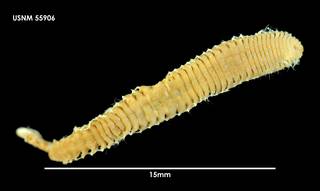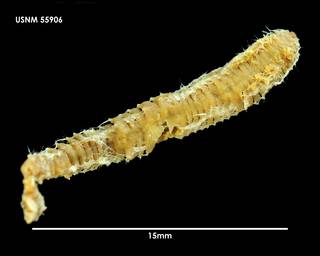| Introduction | | Species lists | | Search taxa | | Taxon tree | | Literature | | Distributions | | Statistics | | Editors | | Match taxa | | Webservice | | Log in |
WoRMS taxon detailsParamphinome australis Monro, 1930
172958 (urn:lsid:marinespecies.org:taxname:172958)
accepted
Species
marine,
recent only
Monro, Charles Carmichael Arthur. (1930). Polychaete worms. <em>Discovery Reports, Cambridge.</em> 2: 1-222., available online at http://biodiversitylibrary.org/page/15904801
page(s): 32-34, fig. 3a-g [details]
Holotype NHMUK 1930.10.8.926, geounit South Orkney Islands
Holotype NHMUK 1930.10.8.926, geounit South Orkney Islands [details] type locality contained in South Orkneys [details]
From editor or global species database
Type locality Off Signy Island, South Orkney Islands, Antarctic Ocean (60º50'30''S, 46º15'00''W), between 244-344 m, in green mud. [details]
Depth range 244-344 m.
Depth range 244-344 m. [details] Distribution Antarctic Ocean, off South Orkney Islands.
Distribution Antarctic Ocean, off South Orkney Islands. [details] Etymology Not stated. The specific epithet australis is a Latin adjective meaning 'southern', and presumably refers to the southern...
Etymology Not stated. The specific epithet australis is a Latin adjective meaning 'southern', and presumably refers to the southern location of the new species, highlighted by Monro (1930: 34): "I believe this to be the first record of this genus in southern waters." [details]
Read, G.; Fauchald, K. (Ed.) (2025). World Polychaeta Database. Paramphinome australis Monro, 1930. Accessed through: World Register of Marine Species at: https://www.marinespecies.org/aphia.php?p=taxdetails&id=172958 on 2025-05-13
Date action by
Nomenclatureoriginal description
Monro, Charles Carmichael Arthur. (1930). Polychaete worms. <em>Discovery Reports, Cambridge.</em> 2: 1-222., available online at http://biodiversitylibrary.org/page/15904801 page(s): 32-34, fig. 3a-g [details] Taxonomytaxonomy source
Georgieva, Magdalena N.; Wiklund, Helena; Ramos, Dino A.; Neal, Lenka; Glasby, Christopher J.; Gunton, Laetitia M. (2023). The annelid community of a natural deep-sea whale fall off eastern Australia. <em>Records of the Australian Museum.</em> 75(3): 167-213., available online at https://journals.australian.museum/georgieva-2023-rec-aust-mus-753-167213/ page(s): 171, figure 5; note: As Paramphinome cf. australis. Record from a whale skull off Byron Bay, NSW, Australia, beam trawl, start: 28.05°S 154.08°E, 999 m, end: 28.10°S 154.08°E, 999-1013 m. Molecular data obtained [details] Available for editors Othercontext source (Deepsea)
Intergovernmental Oceanographic Commission (IOC) of UNESCO. The Ocean Biogeographic Information System (OBIS), available online at http://www.iobis.org/ [details]
additional source Orensanz, José Maria. (1972). Los anelidos poliquetos de la provincia biogeografica Argentina. I. Palmyridae (= Chrysopetalidae), Amphinomidae y Euphrosinidae. <em>Physis.</em> 31(83): 485-501. page(s): 494; note: record and description from offshore Uruguay [details] Available for editors additional source Böggemann, Markus 2009. Polychaetes (Annelida) of the abyssal SE Atlantic. Organisms Diversity & Evolution, 9, 252-428. , available online at http://www.sciencedirect.com/science/article/pii/S1439609209000464 page(s): 278 [details] additional source Kudenov, Jerry D. (1993). Amphinomidae and Euphrosinidae (Annelida: Polychaeta) principally from Antarctica, the Southern Ocean, and Subantarctic regions. <em>Antarctic Research Series, Ser. Biology of the Antarctic Seas XXII.</em> 58: 93-150., available online at https://agupubs.onlinelibrary.wiley.com/doi/10.1029/AR058p0093 page(s): 100-103, figs. 4, 6 [details] Available for editors  Present Present  Present in aphia/obis/gbif/idigbio Present in aphia/obis/gbif/idigbio  Inaccurate Inaccurate  Introduced: alien Introduced: alien  Containing type locality Containing type locality
Holotype NHMUK 1930.10.8.926, geounit South Orkney Islands [details]
From editor or global species database
Depth range 244-344 m. [details]Distribution Antarctic Ocean, off South Orkney Islands. [details] Etymology Not stated. The specific epithet australis is a Latin adjective meaning 'southern', and presumably refers to the southern location of the new species, highlighted by Monro (1930: 34): "I believe this to be the first record of this genus in southern waters." [details] Habitat Green mud, 244-344 m depth. [details] Specimen Holotype deposited at the Natural History Museum, London (NHMUK 1930.10.8.926). [details] Type locality Off Signy Island, South Orkney Islands, Antarctic Ocean (60º50'30''S, 46º15'00''W), between 244-344 m, in green mud. [details] |


